Ulysses HISCALE Publications and Presentations
Measurements of Jupiter's Hot Plasma Population with the Ulysses
HI-SCALE Instrument
Authors: T. P. Armstrong, Dept. of Physics and Astronomy, Univ. of Kansas; L. J. Lanzerotti, AT and T Bell Laboratories; R. E. Gold, S. M. Krimigis, and E. C. Roelof, Johns Hopkins Univ. Applied Physics Laboratory; K. A. Anderson and R. P. Lin, Space Science Laboratory, Univ. of Calif.-Berkeley; M. Pick, Observatorie de Paris, Meudon, France; George Simnett, Univ. of Birmingham, U.K.; E. T. Sarris, Democritos Univ. of Thrace, Greece; A. Balogh, Imperial College, London, U.K.; with crucial assistance from: Carol Maclennan, AT and T Bell Laboratories, James Tappin, Univ. of Birmingham, U.K., and T. H. Choo, Dept. of Physics and Astronomy, Univ. of Kansas.
Presented at: Goertz-Smith Symposium on the Magnetospheres of the Outer Planets, UCLA, June 22-26, 1992.
Outline:
- The HISCALE instrument
- Overview - spectrum, anisotropies, time variations
- Comparison of Ulysses and Voyager observations
- Estimate of auroral inputs
Figures:
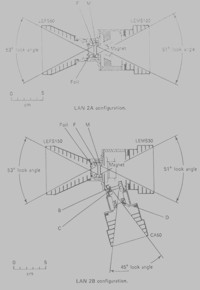 |
Figure 1. LAN 2A and LAN 2B configurations |
 |
Figure 2. Spin plane clock angle (degrees) from spacecraft x-axis |
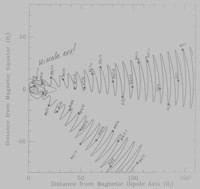 |
Figure 3. |
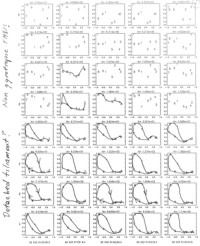 |
Figure 4. |
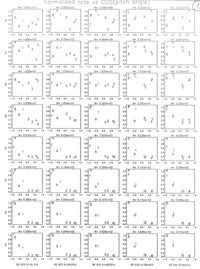 |
Figure 5. |
 |
Figure 6. |
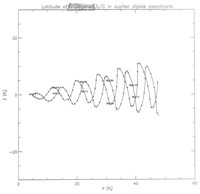 |
Figure 7. |
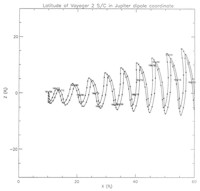 |
Figure 8. |
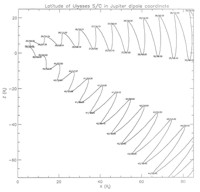 |
Figure 9. |
Table 1. Channels used:

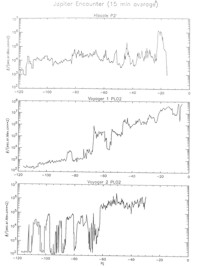 |
Figure 10 - ions |
 |
Figure 11 - electrons |
 |
Figure 12 |
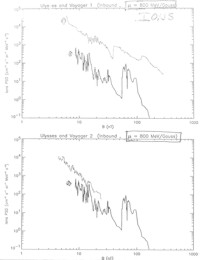 |
Figure 13 |
 |
Figure 14 |
Observe:
- f(μ) for μ=const. decreases with increasing B. Typically, f(μ) µ B-γ where 1~<γ~<3.
- Ulysses and Voyager 2 have similar profiles for μ=500 and 890 MeV/Gauss ions.
- Voyager 2 has much larger electron PSDs than Ulysses (despite #2 above).
- Voyager 1 had much larger ion and electron PSDs than Ulysses.
Provisional Conclusion:
Ulysses and Voyager ion and electron observations are consistent with lossy radial transport of particles from a time-variable, large radial distance, low-latitude source. Solar wind is an obvious candidate.
Table 2 (modified on 4/27/92):

Figure 15. Ulysses trajectory in Jovian dipole coordinates

Data Analyses and Results:
The observations show that during almost all the inbound and outbound passes the pitch angle distributions of electrons and ions are either very isotropic or strongly bi-directional (occurring particularly near the closest encounter). To study the energy fluxes and power inputs for the Jovian aurora, we chose two-hour observed data mostly close to Jupiter during the inbound (92:38:19:0 to 92:38:21:0) and outbound (92:40:01:0 to 92:40:03:0) passes. In this study we used:
Loss cone = arcsin (1 / R2)
Flux area ≈ π(Z22 - Z12)
where Zi = Ri * sin(Lat.i) for i-th data record.
Diff. Flux = Count Rate / G-Factor x Passband
Moreover, we assumed that both electrons and ions have a power-law spectrum, and the power index γ was estimated by
Diff. Flux = J0 (E/E0)-γ
We found that the assumed power-law spectrum agrees very well with both the Ulysses electron and ion data. For the chosen data set, the average γ is about 2.2 ~ 2.5 for ions and about 1.54 ~ 2.2 for electrons, respectively.
With obtained values of γ we can estimate average local energy flux by

and local power input by
Power Input = Energy Flux x Loss Cone x Flux Area
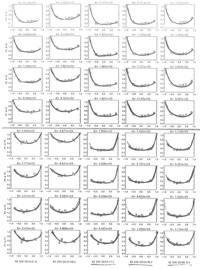 |
Figure 16 |
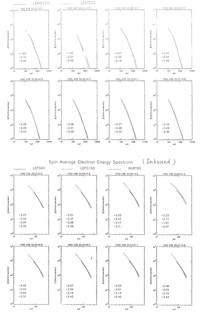 |
Figure 17 - Top: Spin average ions energy spectrum, inbound - LEMS 120 and LEMS 30; Bottom: Spin average electron energy spectrum, inbound - LEFS 60, LEFS 150, and WART 60 |
Summary
- Near the closest encounter with Jupiter, the Ulysses data present a good power law spectrum for both electrons and ions within the whole energy band of the HISCALE experiment, and the power index γ slightly increases with decreasing magnetic latitude.
- The pitch angle distributions of electrons and ions observed by Ulysses at high Jovian magnetic latitudes are basically either isotropic or bi-directional, and the latter indicates strong energetic particle precipitations and Birkeland currents.
- The observed energy flux at latitude γ ~ 20 deg. is estimated at a level of 1.0 erg cm-2 s-1 for 38-315 keV electrons, and approximately one order less, i.e., 0.1 erg cm-2 s-1, for 56-4752 keV ions. This implies that electron precipitation is the major source of particle precipitation from the Jovian magnetosphere down to the Jovian ionosphere.
- Assuming the
observed electron energy input powered the Jovian
aurora, we used a theoretical model of the Jovian
atmosphere and ionosphere and calculated that the
integrated production rate (0<altitude<2030 km) for
H2 Lyman and Werner bands is about 9.67
kR. If the energy efficiency for those bands is 15%,
then a total energy flux of 0.4 erg cm-2 s-1 is
required.
|
Updated 8/8/19, Cameron Crane
QUICK FACTS
Mission End Date: June 30, 2009
Destination: The inner heliosphere of the sun away from the ecliptic plane
Orbit: Elliptical orbit transversing the polar regions of the sun outside of the ecliptic plane



